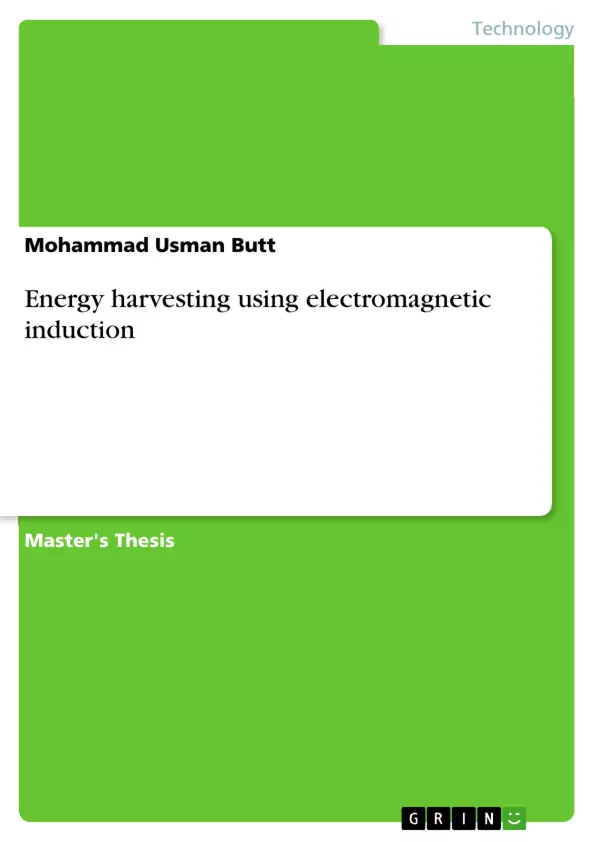The need of energy increases in industrial advancement. To meet the high energy demands with limited natural resources it is desirable to develop energy harvesting systems. This thesis deals with the design of a similar energy efficient system for sensors in production machines. The basic motivation of the system application is to avoid the use of batteries. The batteries need to be replaced after a period of time whereas an energy harvesting system produces its own electrical energy by converting available forms of energies into useful electrical energy for example solar, thermal or vibration energy of the machines into useful electrical energy.
Inhaltsverzeichnis (Table of Contents)
- INTRODUCTION
- ENERGY HARVESTING
- Thermoelectric energy harvesting
- Solar energy harvesting
- Radiofrequency energy
- Vibration energy
- Variable capacitance systems
- Piezoelectric Material Systems
- Magnetostrictive energy harvesting
- Electromagnetic induction
- MAGNETIC INDUCTION SYSTEM DESIGN
- Laws of electromagnetic induction
- Magnetic flux generated by the bar magnet
- Coil inductance and resistance
- Parameters of magnetic material and magnets
- ENERGY HARVESTING SYSTEM DESIGN
- Vibration analysis
- Friction force
- Electromagnetic damping force
- Voltage and power generation
- Coil-through- magnet induction
- Magnet-through- coil induction
- SIMULATIONS
- Resistance of wire against turns of coil
- Damping against turns of coil
- Amplitude of vibration against turns of coil and magnetic field
- Damping force against turns of coil and magnetic field density
- Voltage against turns of coil and magnetic field density
- Amplitude against turns of coil and the air gap
- Damping force against turns of the coil and the air gap
- Voltage against turns of coil and the air gap
- Power against turns of coil and the air gap
- ADJUSTABLE ENERGY HARVESTING SYSTEM
- Active systems
Zielsetzung und Themenschwerpunkte (Objectives and Key Themes)
This Master Thesis focuses on the development of an energy harvesting system that converts vibrations present in production machines into useful electrical energy. The system utilizes the principle of electromagnetic induction with an emphasis on a self-adjusting resonance system.
- Design and development of an energy harvesting system using electromagnetic induction.
- Exploration of a self-adjusting resonance system for optimized energy output.
- Mathematical modeling of mechanical and electrical components, including influencing parameters.
- Optimization of the system for maximum energy output through simulation.
- Analysis of the system's performance under varying conditions.
Zusammenfassung der Kapitel (Chapter Summaries)
The thesis begins with an introduction to energy harvesting, exploring various methods including thermoelectric, solar, radiofrequency, and vibration energy. It delves into specific vibration energy harvesting techniques such as variable capacitance, piezoelectric, magnetostrictive, and electromagnetic induction. The focus then shifts to the design of a magnetic induction system, examining the laws of electromagnetic induction, magnetic flux generation, coil inductance and resistance, and parameters of magnetic materials.
Chapter 4 dives into the design of the energy harvesting system, analyzing vibrations, friction force, electromagnetic damping force, voltage and power generation, and different induction methods. Chapter 5 presents simulation results for various parameters like resistance, damping, amplitude, and voltage under different conditions. Finally, the thesis explores the concept of an adjustable energy harvesting system, specifically focusing on active systems.
Schlüsselwörter (Keywords)
Energy harvesting, electromagnetic induction, vibration energy, resonance system, magnetic flux, coil inductance, damping force, simulation, optimization, self-adjusting.
- Citar trabajo
- Mohammad Usman Butt (Autor), 2009, Energy harvesting using electromagnetic induction, Múnich, GRIN Verlag, https://www.grin.com/document/1184439



